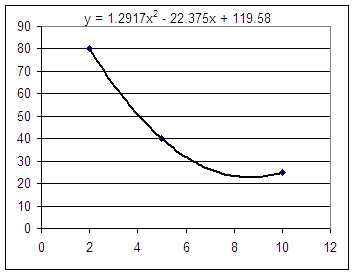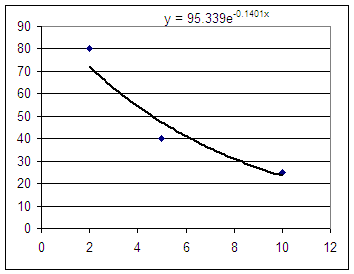I have no idea what do to on
Exercises 3-4 ....Sketch a reasonable graph of y=f(x) if it is known
that f(2)=80, f(5)=40 and f(10)=25.....
I dont know what kind of
formula I need to use...I read all of the Introduction to the
Generalized Modeling Process and found the formulas y=f(x)=ax^2+bx+c.
y=f(x)=Ab^x+c....
y=f(x)=mx+b...Do I use one of those? I am so lost!
You're not lost.
You just need a little clarification on the instruction 'sketch a
reasonable graph... '.
The instruction says
to sketch a reasonable graph. You don't need to find a formula for the
function.
If f(2) = 80 then
the point (2, 80) will lie on the graph.
If f(5) = 40 then the point (5, 40) will lie on the graph.
If f(10) = 25 then the point (10, 25) will lie on the graph.
Sketch a graph
containing these points. Then connect them with any reasonable smooth
curve, and answer the questions based on your picture.
Of course you could
substitute these coordinates for x and y in the model y = a x^2 + b x +
c, as we did last week, and get the formula for a parabola through these
three points. Then you could find the vertex and the points 1 unit
right and left, and sketch a graph based on that model. However I say
this just to remind you of that process, not because I want you to go to
all that trouble here.
I couldn't put this into my posted reply,
but here's a copy of the best-fit quadratic function:

Here's a copy of the best-fit
power function:

And here's a copy of the best-fit
exponential function, which isn't worth much because Excel isn't smart
enough to figure out the best asymptote.



